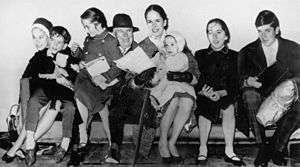Eugene O'Neill
| Eugene O'Neill | |
|---|---|
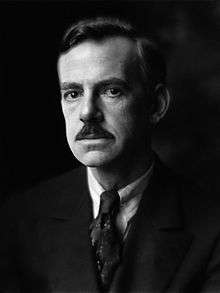 Portrait of O'Neill by Alice Boughton | |
| Born |
Eugene Gladstone O'Neill October 16, 1888 New York City, New York, U.S. |
| Died |
November 27, 1953 (aged 65) Boston, Massachusetts, U.S. |
| Occupation | Playwright |
| Nationality | American |
| Notable awards |
Nobel Prize in Literature (1936) Pulitzer Prize for Drama (1920, 1922, 1928, 1957) |
| Spouse |
Kathleen Jenkins (m. 1909–12) Agnes Boulton (m. 1918; div. 1929) Carlotta Monterey (m. 1929) |
| Children | 3, including Eugene O'Neill, Jr. and Oona O'Neill |
|
| |
| Signature |
|
Eugene Gladstone O'Neill (October 16, 1888 – November 27, 1953) was an American playwright and Nobel laureate in Literature. His poetically titled plays were among the first to introduce into American drama techniques of realism earlier associated with Russian playwright Anton Chekhov, Norwegian playwright Henrik Ibsen, and Swedish playwright August Strindberg. The drama Long Day's Journey into Night is often numbered on the short list of the finest American plays in the 20th century, alongside Tennessee Williams's A Streetcar Named Desire and Arthur Miller's Death of a Salesman.[1]
O'Neill's plays were among the first to include speeches in American vernacular and involve characters on the fringes of society. They struggle to maintain their hopes and aspirations, but ultimately slide into disillusionment and despair. Of his very few comedies, only one is well-known (Ah, Wilderness!).[2][3] Nearly all of his other plays involve some degree of tragedy and personal pessimism.
Early life
O'Neill was born in a hotel, the Barrett House, at Broadway and 43rd Street, on what was then Longacre Square (now Times Square).[4] A commemorative plaque was first dedicated there in 1957.[4][5] The site is now occupied by 1500 Broadway, which houses offices, retail, and ABC Studios.[6]
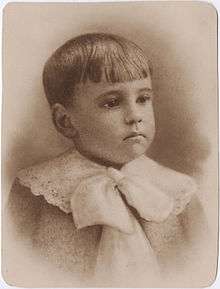
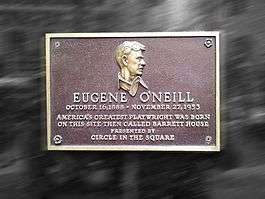
He was the son of Irish immigrant actor James O'Neill and Mary Ellen Quinlan, who was also of Irish descent. Because his father was often on tour with a theatrical company, accompanied by Eugene's mother, O'Neill was sent to St. Aloysius Academy for Boys, a Catholic boarding school in the Riverdale section of the Bronx, where he found his only solace in books. His father suffered from alcoholism; his mother from an addiction to morphine, prescribed to relieve the pains of the difficult birth of her third son, Eugene.
O'Neill spent his summers at the Monte Cristo Cottage in New London, Connecticut. He attended Princeton University for one year. Accounts vary as to why he left. He may have been dropped for attending too few classes,[7] been suspended for "conduct code violations,"[8] or "for breaking a window",[9] or according to a more concrete but possibly apocryphal account, because he threw "a beer bottle into the window of Professor Woodrow Wilson", the future president of the United States.[10]
O'Neill spent several years at sea, during which he suffered from depression and alcoholism. Despite this, he had a deep love for the sea and it became a prominent theme in many of his plays, several of which are set on board ships like those on which he worked. O'Neill joined the Marine Transport Workers Union of the Industrial Workers of the World (IWW), which was fighting for improved living conditions for the working class using quick 'on the job' direct action.[11] O'Neill's parents and elder brother Jamie (who drank himself to death at the age of 45) died within three years of one another, not long after he had begun to make his mark in the theater.
Career
After his experience in 1912–13 at a sanatorium where he was recovering from tuberculosis, he decided to devote himself full-time to writing plays (the events immediately prior to going to the sanatorium are dramatized in his masterpiece, Long Day's Journey into Night). O'Neill had previously been employed by the New London Telegraph, writing poetry as well as reporting.
In the fall of 1914, he entered Harvard University to attend a course in dramatic technique given by Professor George Baker. He left after one year and did not complete the course.

During the 1910s O'Neill was a regular on the Greenwich Village literary scene, where he also befriended many radicals, most notably Communist Labor Party of America founder John Reed. O'Neill also had a brief romantic relationship with Reed's wife, writer Louise Bryant. O'Neill was portrayed by Jack Nicholson in the 1981 film Reds, about the life of John Reed.
His involvement with the Provincetown Players began in mid-1916. O'Neill is said to have arrived for the summer in Provincetown with "a trunk full of plays." Susan Glaspell describes a reading of Bound East for Cardiff that took place in the living room of Glaspell and her husband George Cram Cook's home on Commercial Street, adjacent to the wharf (pictured) that was used by the Players for their theater: "So Gene took Bound East for Cardiff out of his trunk, and Freddie Burt read it to us, Gene staying out in the dining-room while reading went on. He was not left alone in the dining-room when the reading had finished."[12] The Provincetown Players performed many of O'Neill's early works in their theaters both in Provincetown and on MacDougal Street in Greenwich Village. Some of these early plays began downtown and then moved to Broadway.
O'Neill's first published play, Beyond the Horizon, opened on Broadway in 1920 to great acclaim, and was awarded the Pulitzer Prize for Drama. His first major hit was The Emperor Jones, which ran on Broadway in 1920 and obliquely commented on the U.S. occupation of Haiti that was a topic of debate in that year's presidential election.[13] His best-known plays include Anna Christie (Pulitzer Prize 1922), Desire Under the Elms (1924), Strange Interlude (Pulitzer Prize 1928), Mourning Becomes Electra (1931), and his only well-known comedy, Ah, Wilderness!,[3][14] a wistful re-imagining of his youth as he wished it had been. In 1936 he received the Nobel Prize for Literature after he had been nominated that year by Henrik Schück, member of the Swedish Academy.[15] After a ten-year pause, O'Neill's now-renowned play The Iceman Cometh was produced in 1946. The following year's A Moon for the Misbegotten failed, and it was decades before coming to be considered as among his best works.
He was also part of the modern movement to partially revive the classical heroic mask from ancient Greek theatre and Japanese Noh theatre in some of his plays, such as The Great God Brown and Lazarus Laughed.[16]
Family life

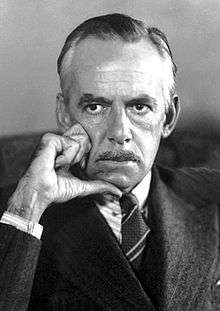
O'Neill was married to Kathleen Jenkins from October 2, 1909 to 1912, during which time they had one son, Eugene O'Neill, Jr. (1910–1950). In 1917, O'Neill met Agnes Boulton, a successful writer of commercial fiction, and they married on April 12, 1918. They lived in a home owned by her parents in Point Pleasant, New Jersey after their marriage.[17] The years of their marriage—during which the couple lived in Connecticut and Bermuda and had two children, Shane and Oona—are described vividly in her 1958 memoir Part of a Long Story. They divorced in 1929, after O'Neill abandoned Boulton and the children for the actress Carlotta Monterey (born San Francisco, California, December 28, 1888; died Westwood, New Jersey, November 18, 1970). O'Neill and Carlotta married less than a month after he officially divorced his previous wife.[18]

In 1929, O'Neill and Monterey moved to the Loire Valley in central France, where they lived in the Château du Plessis in Saint-Antoine-du-Rocher, Indre-et-Loire. During the early 1930s they returned to the United States and lived in Sea Island, Georgia, at a house called Casa Genotta. He moved to Danville, California in 1937 and lived there until 1944. His house there, Tao House, is today the Eugene O'Neill National Historic Site.
In their first years together, Monterey organized O'Neill's life, enabling him to devote himself to writing. She later became addicted to potassium bromide, and the marriage deteriorated, resulting in a number of separations, although they never divorced.
In 1943, O'Neill disowned his daughter Oona for marrying the English actor, director, and producer Charlie Chaplin when she was 18 and Chaplin was 54. He never saw Oona again.
He also had distant relationships with his sons. Eugene O'Neill, Jr., a Yale classicist, suffered from alcoholism and committed suicide in 1950 at the age of 40. Shane O'Neill became a heroin addict and moved into the family home in Bermuda, Spithead, with his new wife, where he supported himself by selling off the furnishings. He was disowned by his father before also committing suicide (by jumping out of a window) a number of years later. Oona ultimately inherited Spithead and the connected estate (subsequently known as the Chaplin Estate).[19] In 1950 O'Neill joined The Lambs, the famed theater club.
| Child | Date of birth | Date of death |
|---|---|---|
| Eugene O'Neill, Jr | 1910 | 1950 |
| Shane O'Neill | 1918 | 1977 |
| Oona O'Neill | 14/05/1925 | 27/09/1991 |
Illness and death
After suffering from multiple health problems (including depression and alcoholism) over many years, O'Neill ultimately faced a severe Parkinsons-like tremor in his hands which made it impossible for him to write during the last 10 years of his life; he had tried using dictation but found himself unable to compose in that way. While at Tao House, O’Neill had intended to write a cycle of 11 plays chronicling an American family since the 1800s. Only two of these, A Touch of the Poet and More Stately Mansions were ever completed. As his health worsened, O’Neill lost inspiration for the project and wrote three largely autobiographical plays, The Iceman Cometh, Long Day's Journey into Night, and A Moon for the Misbegotten. He managed to complete Moon for the Misbegotten in 1943, just before leaving Tao House and losing his ability to write. Drafts of many other uncompleted plays were destroyed by Carlotta at Eugene’s request.

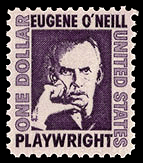
O'Neill died in Room 401 of the Sheraton Hotel on Bay State Road in Boston, on November 27, 1953, at the age of 65. As he was dying, he whispered his last words: "I knew it. I knew it. Born in a hotel room and died in a hotel room."[20] A revised analysis of his autopsy report shows that, contrary to the previous diagnosis, he did not have Parkinson's disease, but a late-onset cerebellar cortical atrophy.[21]
Dr. Harry Kozol, the lead prosecuting expert of the Patty Hearst trial, treated O'Neill during these last years of illness. He also was present for O'Neill's death and announced the fact to the public.[22]
O'Neill is interred in the Forest Hills Cemetery in Boston's Jamaica Plain neighborhood.
In 1956 Carlotta arranged for his autobiographical play Long Day's Journey into Night to be published, although his written instructions had stipulated that it not be made public until 25 years after his death.[23] It was produced on stage to tremendous critical acclaim and won the Pulitzer Prize in 1957. This last play is widely considered to be his finest. Other posthumously-published works include A Touch of the Poet (1958) and More Stately Mansions (1967).
The United States Postal Service honored O'Neill with a Prominent Americans series (1965–1978) $1 postage stamp.
Influence on African American actors
O’Neill had major influence on African American actors, in particular Paul Leroy Robeson. O’Neill and Robeson worked on three productions together: All God's Chillun Got Wings (1924), The Emperor Jones (1924), and The Hairy Ape (1931). Robeson, however, did not originate the lead role in O’Neill's The Emperor Jones. Charles Sidney Gilpin, a respected leading man from the all-black Lafayette Players of Harlem, was the first actor to play the role of Brutus Jones when it was first staged on November 1, 1920, by the Provincetown Players at the Playwright's Theater in New York City. This production was O'Neill's first real smash hit. The Players' small theater was too small to cope with audience demand for tickets, and the play was transferred to another theater. It ran for 204 performances and was hugely popular, and toured in the States with this cast for the next two years. Gilpin continued to perform the role of Brutus Jones in the U.S. tour that followed the Broadway closing of the play, and In 1920 became the first black American to receive the Drama League of New York's annual award as one of the ten people who had done the most that year for American theater. The following year Gilpin was awarded the NAACPs Spingarn Medal. He was also honored at the White House by president Warren G. Harding. A year later, the Dumas Dramatic Club (now the Karamu Players) of Cleveland renamed itself the Gilpin Players in his honor. Though the acclaimed actor continued to perform in subsequent productions of the play, he eventually had a falling out with O'Neill who argued with Gilpin's tendency to change his use of the word "nigger" to Negro and colored during performances. Gilpin wanted O'Neill to remove the word "nigger" from the play altogether, which occurred frequently in the play, but the playwright refused, arguing its use was consistent with his dramatic intentions and that the use of language was, in fact, based on a friend, an African-American tavern-keeper on the New London waterfront that was O'Neill's favorite drinking spot in his home town. When they could not come to a reconciliation, O'Neill replaced the middle-aged Gilpin with the much younger and then unknown Paul Robeson, who had only performed on the concert stage. Robeson starred in the title role in the 1924 New York revival and in the London production. He received excellent reviews and, coupled with his performance in the 1928 London production of the musical Show Boat, went on to worldwide fame as one of the great black artists of the 20th century. The show was again revived in 1926 at the Mayfair Theatre in Manhattan, with Gilpin again starring as Jones and also directing the show. The production, which ran for 61 performances, is remembered today for the acting debut of a young Moss Hart as Smithers and broke social barriers and defied conventions of the day as the first American play to feature an African-American central character portrayed in a serious manner.[24] The play was adapted for a 1933 feature film starring Paul Robeson, directed by Dudley Murphy, an avant-garde filmmaker of O'Neill's Greenwich Village circle who pursued the reluctant playwright for a decade before getting the rights from him. Gilpin continued to make a small living performing monologues from O'Neill's play at church gatherings, but after the extended controversy and the disappointment of losing his signature role, succumbed to depression and began drinking heavily. He never again performed on Broadway and died in 1930 in Eldridge Park, New Jersey, his career in shambles. He was buried in an unmarked grave in Woodlawn Cemetery in the Bronx, his funeral arranged by friends shortly after his death.
Legacy
In Warren Beatty's 1981 film Reds, O'Neill Is portrayed by Jack Nicholson, who was nominated for the Academy Award for Best Supporting Actor for his performance.
George C. White founded the Eugene O'Neill Theatre Center in Waterford, Connecticut in 1964.[25]
Eugene O'Neill is a member of the American Theater Hall of Fame.[26]
O'Neill is referenced by Tony Stark in Avengers: Age of Ultron (2015), specifically Long Day's Journey into Night.
Museums and collections
O'Neill's home in New London, Monte Cristo Cottage, was made a National Historic Landmark in 1971. His home in Danville, California, near San Francisco, was preserved as the Eugene O'Neill National Historic Site in 1976.
Connecticut College maintains the Louis Sheaffer Collection, consisting of material collected by the O'Neill biographer. The principal collection of O'Neill papers is at Yale University. The Eugene O'Neill Theater Center in Waterford, Connecticut fosters the development of new plays under his name.
There is also a Theatre in New York City named after him located at 230 West 49th Street in midtown-Manhattan. The Eugene O'Neill Theatre has housed musicals and plays such as Yentl, Annie, Grease, Spring Awakening, and The Book of Mormon.
Work
Full-length plays
|
One-act playsThe Glencairn Plays, all of which feature characters on the fictional ship Glencairn—filmed together as The Long Voyage Home:
Other one-act plays include:
|
Other works
- The Last Will and Testament of an Extremely Distinguished Dog, 1940. Written to comfort Carlotta as their "child" Blemie was approaching his death in December 1940.[29]
See also
References
- ↑ Harold Bloom (2007). Introduction. In: Bloom (Ed.), Tennessee Williams, updated edition. Infobase Publishing. p. 2.
- ↑ The New York Times, August 25, 2003: 'Next year Playwrights Theater will present an unproduced O'Neill comedy, Now I Ask You, a comic spin on Ibsen's Hedda Gabler."
- 1 2 3 The Eugene O'Neill Foundation newsletter: "Now I Ask You, along with The Movie Man, ... is the only surviving comedy from O’Neill’s early years."
- 1 2 Gelb, Arthur (October 17, 1957). "O'Neill's Birthplace Is Marked By Plaque at Times Square Site". The New York Times. p. 35. Retrieved November 13, 2008.
- ↑ Simonson, Robert (July 23, 2012). "Ask Playbill.com: A Question About Eugene O'Neill's Birthplace, in a Broadway Hotel". Playbill. Retrieved November 8, 2016.
- ↑ Henderson, Kathy (April 21, 2009). "The Tragic Roots of Eugene O'Neill's Desire Under the Elms". Broadway.com. Retrieved November 8, 2015.
- ↑ Manheim, Michael, ed. (1998). The Cambridge Companion to Eugene O'Neil. Cambridge: Cambridge University Press. p. 97.
- ↑ Bloom, Steven F. (2007). Student Companion to Eugene O'Neil. Westport: Greenwood Press. p. 3.
- ↑ Abbotson, Susan C.W. (2005). Masterpieces of 20th-Century American Drama. Westport: Greenwood Press. p. 8.
- ↑ O'Neill, Eugene (1959). Ah, Wilderness!. Frankfurt am Main: Hirschgraben-Verlag. p. 3.
- ↑ Patrick Murfin. "The Sailor Who Became "America's Shakespeare"". Heretic, Rebel, a Thing to Flout. Retrieved November 8, 2016.
- ↑ Glaspell, Susan (1941) [1927]. The Road to the Temple (2nd ed. ed.). New York: Frederick A. Stokes. p. 255.
- ↑ Renda, Mary (2001). Taking Haiti: Military Occupation and the Culture of U.S. Imperialism. Chapel Hill: University of North Carolina Press. pp. 198–212. ISBN 0-8078-4938-3.
- ↑ van Gelder, Lawrence (August 25, 2003). "Arts Briefing". The New York Times. Retrieved November 8, 2016.
- ↑ "Nomination Database". Nobelprize.org. Retrieved November 8, 2016.
- ↑ Smith, Susan Harris (1984). Masks in Modern Drama. Berkeley: University of California Press. pp. 66–70, 106–08, 131–36, index S124. ISBN 0-520-05095-9.
- ↑ Cheslow, Jerry. "If You're Thinking of Living In/Point Pleasant, N.J.; A Borough With a Variety of Boating", The New York Times, November 9, 2003. Accessed January 25, 2015. "The most famous Point Pleasant resident was Eugene O'Neill, who married a local girl named Agnes Boulton and grumbled about being bored through the winter of 1918-19, as he lived rent free in a home owned by Agnes's parents.
- ↑ "Eugene O'Neill Wed to Miss Monterey". The New York Times. 1929-07-24. p. 9. Retrieved 2008-11-13.
- ↑ "Bermuda's Warwick Parish".
- ↑ Sheaffer, Louis (1973). O'Neill: Son and Artist. Little, Brown & Co. ISBN 0-316-78337-4.
- ↑ "Eugene O'Neill - What Went Wrong?". Neuroscience for Kids. April 22, 2000. Retrieved November 8, 2016.
- ↑ "Eugene O'Neill Dies of Pneumonia; Playwright, 65, Won Nobel Prize". The New York Times. November 28, 1953. Retrieved November 8, 2016.
- ↑ Carlotta’s Obituary
- ↑ "American Drama Transformed". National Park Service. Retrieved November 8, 2016.
- ↑ "Eugene O'Neill Theatre Center Website". Retrieved 4 March 2014.
- ↑ "Theater Hall of Fame members".
- ↑ Title as in original typescript and title page of Modern Library edition
- ↑ "Exorcism". Yale U. Library Acquires Lost Play by Eugene O'Neill. Chronicle of Higher Education. October 19, 2011. Retrieved October 22, 2011. (The play, set in 1912, is based on O’Neill’s suicide attempt from an overdose of barbiturates in a Manhattan rooming house. After its premiere in 1920, O’Neill canceled the production and, it had been thought, destroyed all copies.)
- ↑ O'Neill, Eugene; Yorinks, Adrienne (1999). The Last Will and Testament of an Extremely Distinguished Dog (First ed.). New York: Henry Holt and Co. ISBN 0-8050-6170-3. Retrieved 2008-11-16.
Further reading
Editions of O'Neill
- O'Neill, Eugene; Bogard, Travis (1988). Complete Plays 1913–1920. The Library of America. 40. New York: Literary Classics. ISBN 0-940450-48-8.
- O'Neill, Eugene; Bogard, Travis (1988). Complete Plays 1920–1931. The Library of America. 41. New York: Literary Classics. ISBN 0-940450-49-6.
- O'Neill, Eugene; Bogard, Travis (1988). Complete Plays 1932–1943. The Library of America. 42. New York: Literary Classics. ISBN 0-940450-50-X.
Scholarly works
- Black, Stephen A. (2002). Eugene O'Neill: Beyond Mourning and Tragedy. Yale University press. ISBN 0-300-09399-3.
- Clark, Barrett H. (November 1932). "Aeschylus and O'Neill". The English Journal. XXI (9): 699–710. doi:10.2307/804473. JSTOR 804473.
- Clark, Barrett H. (1926). Eugene O'Neill: The Man and His Plays. Dover Publications, Inc. New York.
- Dowling, Robert M. (2014). Eugene O'Neill: A Life in Four Acts. Yale University Press. ISBN 978-0-300-17033-7.
- Floyd, Virginia (editor) (1979). Eugene O'Neill: A World View. Frederick Unger. ISBN 0-8044-2204-4.
- Floyd, Virginia (1985). The Plays of Eugene O'Neill: A New Assessment. Frederick Unger. ISBN 0-8044-2206-0.
- Gelb, Arthur & Barbara (2000). O'Neill: Life with Monte Christo. Applause/Penguin Putnam. ISBN 0-399-14912-0.
- Sheaffer, Louis (2002) [1968]. O'Neill Volume I: Son and Playwright. Cooper Square Press. ISBN 0-8154-1243-6.
- Sheaffer, Louis (1999) [1973]. O'Neill Volume II: Son and Artist. Cooper Square Press. ISBN 0-8154-1244-4.
- Tiusanen, Timo (1968). O’Neill’s Scenic Images (Ph.D. thesis, University of Helsinki). Princeton: Princeton University Press. LCCN 68-20882.
- Wainscott, Ronald H. (1988). Staging O’Neill: The Experimental Years. Yale University Press. ISBN 0-300-04152-7.
- Winther, Sophus Keith (1934). Eugene O’Neill: A Critical Study. New York: Random House. OCLC 900356.
External links
- Eugene O'Neill official website
- Casa Genotta official website
- Works by Eugene O'Neill at Project Gutenberg
- Works by or about Eugene O'Neill at Internet Archive
- Works by Eugene O'Neill at LibriVox (public domain audiobooks)

- Works by Eugene O'Neill at Open Library

- Eugene O'Neill at the Internet Broadway Database

- Eugene O'Neill at the Internet Off-Broadway Database
- Eugene O'Neill at the Internet Movie Database
- Eugene O'Neill | PlaybillVault.com
- Eugene O'Neil Autobiography at the Nobel Foundation
- The Iceman Cometh: A Study Guide
- Eugene O'Neill: A Life in Four Acts | Robert M. Dowling at Amazon
- Works by Eugene O'Neill at Project Gutenberg Australia
- Eugene O'Neill National Historic Site
- American Experience - Eugene O'Neill: A Documentary Film on PBS
- Works by Eugene O'Neill (public domain in Canada)
- Haunted by Eugene O'Neill—Article in BU Today, Sept. 29, 2009
- Eugene O’Neill: the sailor, the sickness, the stage from the Museum of the City of New York Collections blog
- Carlotta O'Neill notebook of letters and photographs, 1927-1954, held by the Billy Rose Theatre Division, New York Public Library for the Performing Arts. The notebook contains handwritten transcriptions by Carlotta O'Neill of letters and inscriptions to her from her husband, Eugene O'Neill, and photographs, mostly portraits of Eugene and Carlotta O'Neill.
| Awards and achievements | ||
|---|---|---|
| Preceded by Warren S. Stone |
Cover of Time magazine March 17, 1924 |
Succeeded by Raymond Poincaré |
